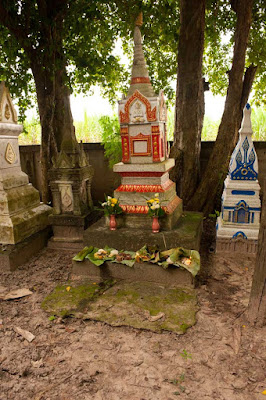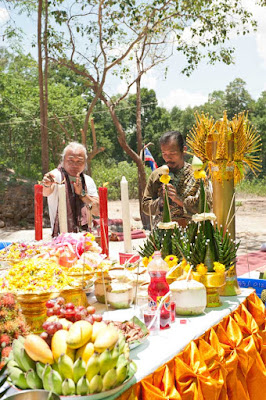 |
| A Villager Makes Food Offering At the Base of A Tat for the Spirit of a Departed Relative |
Sunday was a special day in Isaan. September 27 2015, 2558 BE, was Wan Kao Saht. It is the Mid-Autumn Festival or Moon Festival. For Westerners it is the "Harvest Moon".
On this special merit making is performed in offering food to the Phii (ghosts). People also earn merit through offering a special treat called "Kao Tawtek" to their local Monks. Kao Tawtek is a mixture of freshly popped rice, caramel, peanuts, shredded coconut and millet. It is made in backyards, front yards, and side yards throughout Isaan just prior to Wan Kao Saht - typically in huge woks over wood fires. It is also traditional for older people to give gifts of Kao Tawtek and money to children.
Like many things here in Thailand, Wan Kao Saht seems to be adapted and amalgamated from other cultures. The Chinese celebrate a Hungry Ghost Festival and "Ghost Day" around the same time. In Vietnam, the second biggest holiday with an emphasis and focus on children is celebrated at this time of the year.
I drove out to Tahsang Village, my wife's home village, early this morning to be able to participate in the daily merit making ritual of offering food to the Monks. Although I left early in the morning, I was not as early as Duang. She left our home at 6:00 A.M. to prepare for the ritual at the Wat outside of the village. I drove through the bright green rice paddies, "high as an elephant's eye" sugar cane fields, and muddy fields lying in fallow, before I arrived at the "Outside" Wat (Wat Pha That Nong Mat).
On Wan Kao Saht, in addition to earning personal merit, the participants earn merit for the spirits of their dead relatives. In the Lao Loum culture, as well as other Southeast Asia cultures, the people have to take care of the spirits of their family as well as other ghosts. Spirits need merit in death as well in life to assist them in their journey to enlightenment. Merit is the basis for determining what form and status a person will be reincarnated as.
 |
| Typical Daily Ritual of Making Food Offerings to the Monks |
 |
| Baskets of Food Offerings for the Phii (Spirits) |
Many of the women were dressed in white uniforms like the attire that Duang wears just about every night when she conducts her ritual upstairs in our home where my roll top desk has been converted into a shrine. The women, including Duang's mother, were participating in a women's retreat at the Wat. They spent the remainder of the day and most of the night reading and studying the scriptures and receiving lectures from the Monks.
 |
| In Buddhist Rituals, You Can Smile and Even Talk If You Want To |
The offering of food to the Monks was a typical daily ritual with one exception, while the Monks ate their one meal of the day, the women in the white costumes along with a couple of Brahmans chanted in Pali for most of the time.
At the end of the ritual, the villagers gathered up their baskets and went outside. The villagers scattered throughout the Wat grounds selecting specific trees to stop at. My mother-in-law and several other women selected a large bohdi tree (Ficus religiosa). She squatted down next to the exposed roots of the sacred tree. It is considered sacred because it is said that Buddha sat under bohdi trees while meditating. Yai Puh, Grandmother Puh, laid out food for the spirits of deceased family members. The food was placed upon banana leaves and consisted of peeled fruits, sticky rice, chili sauces, dried fish, and other typical Isaan foods. Off to the side was a banana leaf with betel-nut chewing items. After the foods were laid out, water was poured over them as the family members said things along the lines of "You come down now to eat. Good for you. I miss you. You look after family. Good luck for you. You go back up to Buddha.
 |
| Placing Banana Leaf Packets of Food for Phii |
Duang and some other women, made food offerings to the spirits of relatives whose bones are kept in highly decorated steeple or spire shaped structures called "Tats". Tats are reliquaries for bone chips of departed ancestors. More affluent villagers have a free standing tat and those less affluent will often have a niche inside of the block walls that surround Wats.
 |
| Food Offerings At A Family Tat |
 |
| Duang Making Food Offering to Her Father's Spirit |
After a while, perhaps ten minutes, one of the men rang the Wat large bell three times signifying that the spirits had completed eating. The small banana leaf packets were quickly removed from the trees and returned to the family baskets. The packets will later be placed in the sugar cane fields, rice paddies, and other lands to feed the spirits (ghosts) that inhabit them. In return for feeding the hungry ghosts, the people ask that the spirits watch over the land and its crops bringing success as well as good luck to the owners.
 |
| Offerings to the Ghosts |
The villagers returned to the Viharn to have a community meal with the food leftover from the offerings to the Monks. There is always too much food offered to the Monks and since they are allowed to take only what they can eat that morning for their one meal of the day there are always "leftovers". The food, that the Monks have not taken, is eaten by the laypeople in a community meal in the Viharn after the Monks have left.
We returned to our home for a relaxing afternoon. In the late afternoon, Duang offered food and drink outside our home to the spirits of our land. After dinner she put on her religious attire and performed her nightly ritual which lasts about one hour.
Life goes on here in Isaan measured in part by the seasons of the crops and the cycle of religious events. Whether it is the seasons of the crops, the cycle of religious events, or personal life milestones, life here always is interesting and is often "enlightening".



















































